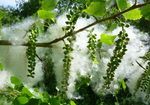
PAWLOWSKI Tomasz A.
Recommendations: 0
Review: 1
Review: 1

Variability in seeds’ physicochemical characteristics, germination and seedling growth within and between two French Populus nigra L. populations
Black poplar (Populus nigra L.) seed physiology: an important issue for the in situ conservation of this riparian species
Recommended by Erwin Dreyer based on reviews by Tomasz A. Pawlowski, Eduardo Notivol and 1 anonymous reviewerSeed physiology, which was a little forgotten in forest ecology since several decades, needs be revitalized as a research area given the many open questions about population dynamics and demography in rapidly changing environments (and not only for endangered species).
Indeed, seed physiology was long mobilized mainly to optimize seed conservation and germination for the production of plant material in a range of tree species used for afforestation/plantation. In the case of back poplar (which by the way is the male genitor of the multiple hybrid Populus x euramerica poplar cultivars), the focus is rather on the conservation ecology of this riparian species, and mainly on in situ conservation (Lefèvre et al, 1998). Indeed, the protection of populations of Populus nigra L requires an improved understanding of the ecology of this species with a focus on reproduction. Indeed, black poplar seeds need to be rapidly disseminated, to germinate as soon as the conditions are favourable (with rather small time windows) and establish seedlings with access to water in the rather harsh environment of mobile and sandy river banks submitted to alternating periods of flooding and of severe water deficits during low river flows in summer (Imbert and Lefèvre, 2003; Corenblit et al, 2014; Tinschert et al, 2020).
This process is therefore central to the propagation/maintenance of these populations that are threatened by the destruction of river banks and by introgression by either genes from the widespread “Italica” cultivar of black poplar, of from other poplar species leading to a variety of natural hybrids (Smulders et al, 2008).
Many questions remain open about seeds of black poplar (Michalak et al, 2015). One of the most intriguing one is to what extent seed properties and physiology differ within and among local populations from different river catchments. This question was addressed in this preprint by Lefebvre et al. (2021) that provides a very detailed and comparative analysis of two populations from central and southern France, each represented by 10 half sib families (i.e., seed collected separately from 10 adult individuals after open pollination).
Investigated properties were mainly seed biomass, anatomy, germination rate, root growth, lipid and sugar contents, protein content (with identification of some major protein families).
The within populations variability was indeed quite large, but nevertheless there were significant differences between the two populations in several traits, like seed weight, lipid content, and starch content. Storage proteins differed among families, but only slightly between the two populations. However, the main conclusion was that intrinsic qualities of the seeds were not critical for early stage establishment in the two populations, despite some significant differences in mean seed biomass, in lipid and in soluble sugars contents.
The preprint nicely analyses these differences, brings a large set of new observations about the seed physiology of Populus nigra. The referees found the data produced during this research quite important and original. This is why, despite the fact that the number of tested groups of populations remains rather small and the link with seedling establishment remains rather weak, this study is an important contribution to conservation ecology. This research (and that of many other groups) needs be further developed with an emphasis on inter and intra population variation and on demogenetics of forest tree species.
References
Corenblit D., Steiger J., González, E et al. (2014), The biogeomorphological life cycle of poplars during the fluvial biogeomorphological succession: a special focus on Populus nigra L.. Earth Surf. Process. Landforms, 39: 546-563. doi: https://doi.org/10.1002/esp.3515
Imbert E. and Lefèvre F. (2003) Dispersal and geneflow of Populus nigra (Salicaceae) along a dynamic river system. Journal of Ecology 91: 447-456. doi: https://doi.org/10.1046/j.1365-2745.2003.00772.x
Lefebvre M., Villar M., Boizot N., Delile A., Dimouro B., Lomelech A.-M. and Teyssier, C. (2021) Variability in seeds’ physicochemical characteristics, germination and seedling growth within and between two French Populus nigra populations. arXiv, 2008.05744, ver 3 peer-reviewed and recommended by Peer community in Forest and Wood Sciences. https://arxiv.org/abs/2008.05744
Lefèvre F., Légionnet A., de Vries S. and Turok J. (1998) Strategies for the conservation of a pioneer tree species, Populus nigra L., in Europe. Genetics, Selection, Evolution 30, S181-196. doi: https://doi.org/10.1186/1297-9686-30-S1-S181
Michalak M., Plitta B.P., Tylkowski T. et al. (2015) Desiccation tolerance and cryopreservation of seeds of black poplar (Populus nigra L.), a disappearing tree species in Europe. European Journal of Forest Research 134, 53–60. doi: https://doi.org/10.1007/s10342-014-0832-4
Smulder M.J.M., Beringen R., Volosyanchuk R. et al. (2008) Natural hybridisation between Populus nigra L. and P. x canadensis Moench. Hybrid offspring competes for niches along the Rhine river in the Netherlands. Tree Genetics & Genomes 4, 663–675. doi: https://doi.org/10.1007/s11295-008-0141-5
Tinschert E., Egger G., Wendelgass J. et al. (2020) Alternate reproductive strategies of Populus nigra influence diversity, structure and successional processes within riparian woodlands along the Allier River, France. Journal of Hydro-environment research 30, 100-108. doi: https://doi.org/10.1016/j.jher.2020.03.004